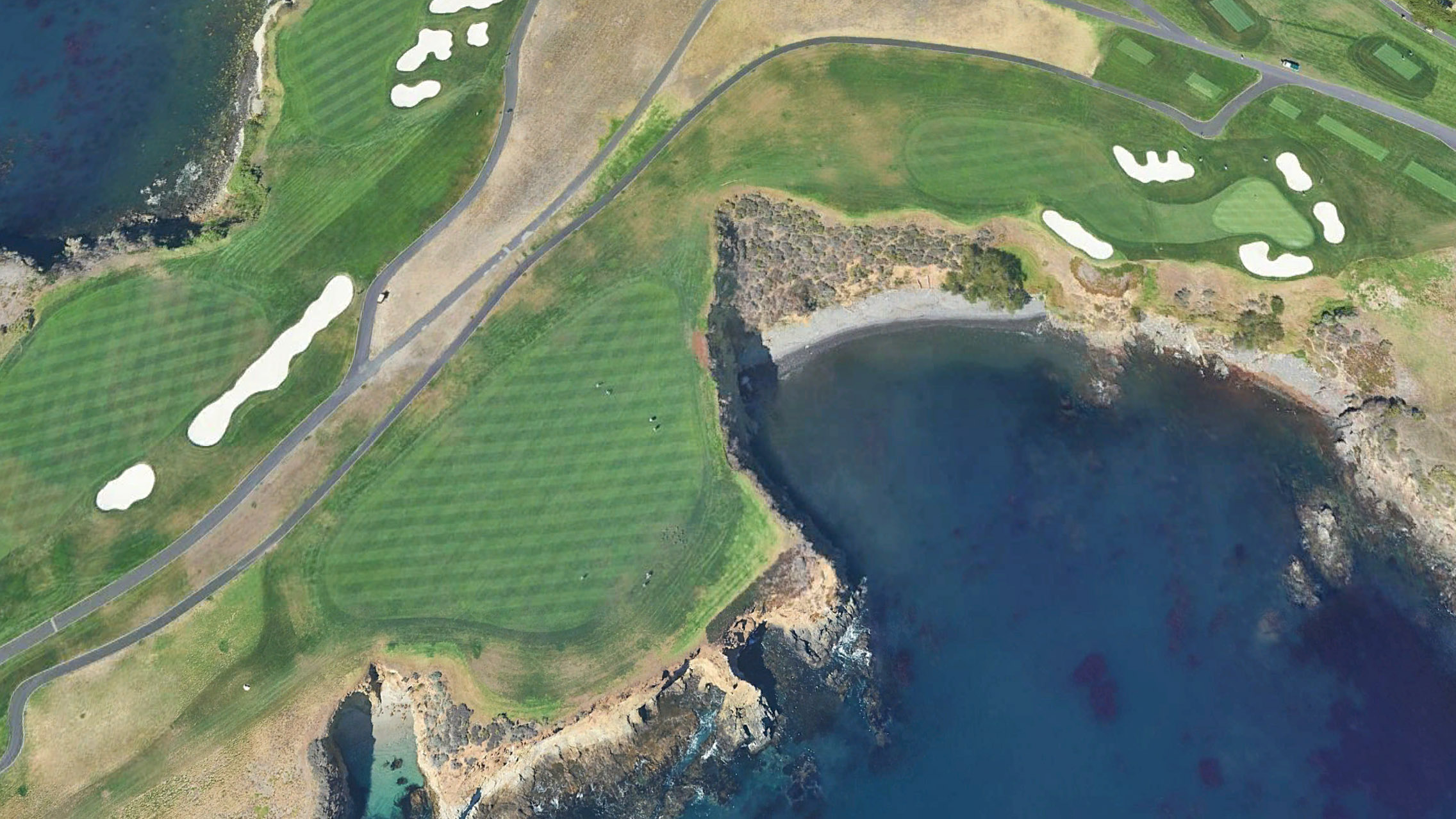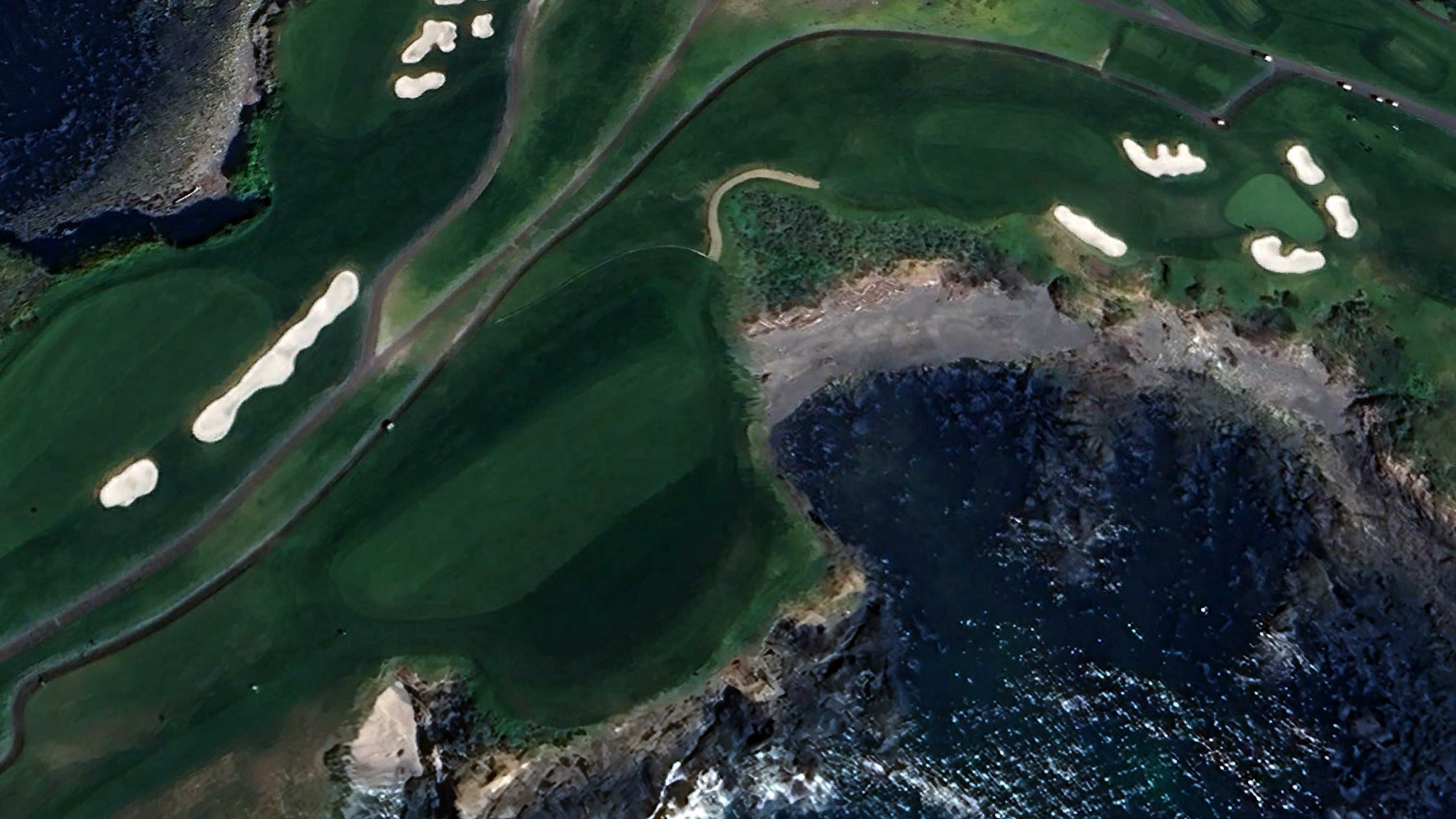First, a couple of definitions:
Course management is the set of strategies that a player uses to negotiate a golf course with the goal of shooting as low a score as possible. Course design is the set of tasks that an architect completes in order to make a golf course as functional, exciting, strategically interesting, and aesthetically pleasing as possible.
So course management and course design are two different things. Yet they often get confused with each other when we discuss tournament golf venues.
Consider the case of the new mowing lines on the famous par-4 eighth hole at Pebble Beach. Ahead of last year’s U.S. Women’s Open, the resort decided to narrow this fairway from about 70 yards across to about 35 yards across. This setup decision had a big effect on the design of the hole. Whereas the old fairway allowed for a broad range of outcomes off the tee and angles into the green, the new one said, basically, “Hit me or else.”


(Let me pause here to clarify that I love Pebble, know that many golfers dream of playing it, and realize that criticizing its fairway widths may seem nitpicky or ungrateful. I just think the course could be even better.)
Pebble Beach brought in a handful of other mowing lines—notably on the second, fourth, sixth, 11th, 16th, and 18th holes—and, after the USGA left town, elected not to push them back out. Some players at this week’s AT&T Pebble Beach Pro-Am have been surprised by the fairway widths. “The rough has been taken in on quite a few holes, more so than usual,” Jordan Spieth said. “That’s probably the biggest difference [from past years], is the narrowing of the fairways.”
When we tweeted about the issue, we caught a reply from PGA Tour pro and Golf Twitter personality Michael Kim. In response to our claim that the updated mowing lines “eliminat[ed] any strategy off the tee,” Kim asked, “What are different strategies on 8?”
Look, we left our flank open here. We probably should have said that the narrowed fairway “takes away options” or “restricts potential outcomes,” or even that it “looks ridiculous.” But we used the word “strategy,” and that moved us into Kim’s area of expertise: course management.
Kim’s argument will be familiar to anyone who follows a Mark Broadie-influenced golf instructor on social media or has watched Golf Channel while Brandel Chamblee is on the clock. “The only goal on that tee shot,” Kim wrote, “is to hit the fairway and any piece of the fairway. No one is trying to find a different angle. With it being a blind shot and trying to hit it like 230, we’re only thinking fairway.” (Broadie himself “liked” this tweet, incidentally.)
Fair enough. Michael Kim is an authority on course management, and no doubt his assertions about how to shoot low scores are accurate.
But again, course management and course design are two different things.
In considering the design question of whether Pebble Beach was right to change the eighth hole, we shouldn’t just think about the effect on a tour pro’s strategy. Bringing in the mowing lines had a number of other consequences, including:
1. Greater emphasis on driving accuracy. The narrower fairway on No. 8 probably does place a higher premium on accuracy off the tee, which is what Pebble Beach intended. The second shot has to carry a wide chasm and hold a tiny, canted, pushed-up green, so when the rough is up (which, granted, it rarely is during the Pebble Beach Pro-Am), playing from the fairway is a huge advantage.
2. More difficulty for the amateur. This is the flip-side of the above point. There’s a reason that the eighth fairway has traditionally been 70 yards wide: the second shot is hard enough for average players when they’re not hitting out of the rough. Using tournament mowing lines for regular play just means more ProV1s will find their way into the Pacific Ocean.
3. Disconnection from the coastline. Tightening the eighth fairway separated the hole strategically and aesthetically from Pebble Beach’s greatest asset: its spectacular ocean frontage. Yes, Spieth’s cliff is still in play, but the fairway no longer extends to the bluffs on the right. As a result, the tee shot is almost more about the rough than the greatest natural hazard in the game, and that’s a shame.
4. Fewer options to contemplate from the tee. This is where Michael Kim might pop in and say, “The only option you should contemplate is hitting the fairway!”
Sure, valid. But I can tell you this: the first time I played the eighth hole at Pebble Beach, years ago, I talked with my caddie about a range of options. I could hit a hybrid directly over the aiming rock and be safe, but I’d have a long way in. If I were to go with a 3-wood, on the other hand, I could aim toward the long left section of the fairway—now covered in rough—and leave myself a shorter approach from a good angle. I chose the latter option, of course, and ended up in position A (and proceeded to fire my ball into the crevasse).
Should I have simply asked my caddie which play gave me the best chance of avoiding both the rough and the cliffs? If scoring had been my sole objective, sure. But I was at Pebble Beach, I was having fun, and I’m glad the design gave me the opportunity to entertain some risk-reward scenarios above the crashing waves.
Golf course design is about golf, and golf is about more than competing.
This piece originally appeared in the Fried Egg Golf newsletter. Subscribe for free and receive golf news and insight every Monday, Wednesday, and Friday.


 by
by 
